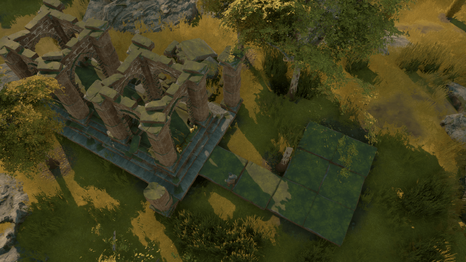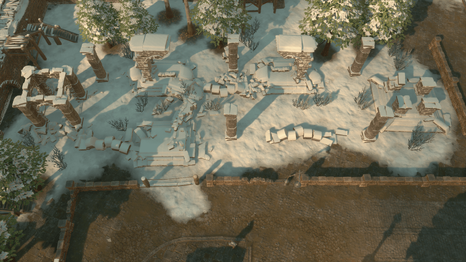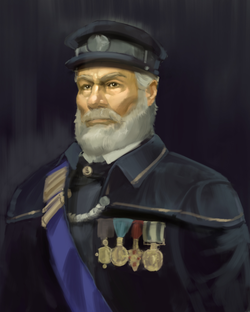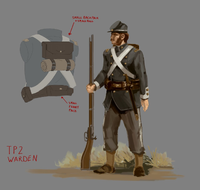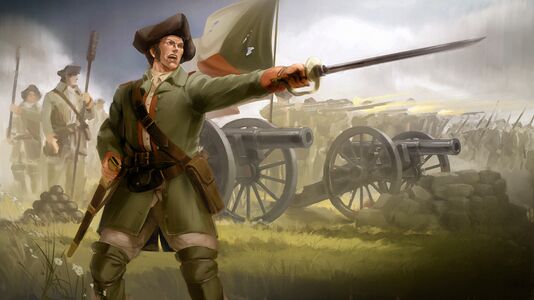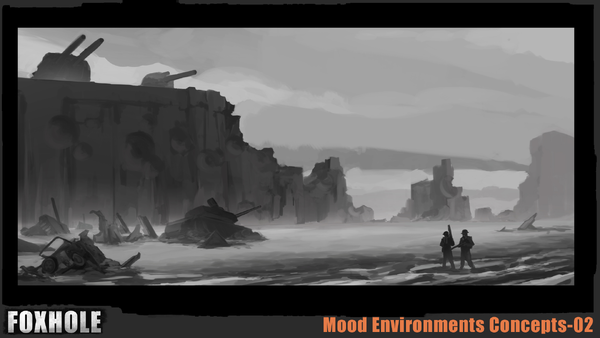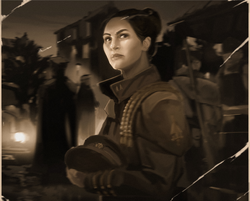History
}}
Foxhole is set in an alternate universe, drawing inspiration from early 20th-century warfare and technology. The game is entirely fictional, despite some misconceptions that it takes place during World War I or II. The developers have made it clear that Foxhole is not a simulator for these wars. Instead, their goal is to provide players with an immersive experience that captures the essence of war in these eras, incorporating grounded combat and strategies from those times.
The Factions in Foxhole are not affiliated with any real-world armies, and they do not correspond to forces such as the Allies and Axis from World War 2. However, they may draw inspiration from actual militaries. Furthermore, it is important to note that neither faction is depicted as superior or morally superior to the other. While some of the lore pieces in the game may be biased, as a whole, they offer a more comprehensive perspective without favoring either faction.
| “ | The Wardens and Colonials are fictional factions from the alternate universe that Foxhole takes place in. They are not representative of any nation/group from real history and neither faction serves as the "good guys" or "bad guys" in the world. | „ |
| — Foxhole's official website FAQ |
Universe Timeline
Here is what we currently believe the Timeline of the Foxhole Universe to look like. It is very limited, with many gaps and time jumps existing, as we lack the proper information to date these events. Despite this, it should be relatively correct, at least until further information is revealed to prove or disprove the claims made here.
Dates in Foxhole start at the year 0, and although we do not know what event marks the beginning of History in this world it was an event important enough for both Colonials and Wardens to utilise the same calendar. The game proper takes place in the early 1000s.
The Less Sophisticated Times
The Less Sophisticated Times[1] is a fan-made term used to encompass all of the world's history before the in-universe usage of exact dates an timeframes. The length and chronology of these events is unknown. It is possible some event’s may even predate Year 0. The general technological level of this era is varied, although by the end of the period the first firearms had already become widely used.[2]
The timeline begins in the norther fringes of Raka,[3] where the lands of Caoiva (pronounced "See-vah") were divided into many disparate chiefdoms, each led by individual Clans. While the structure an organization of these groups varied, they were all considered to be Caoivish, sharing traditions and holding a long history of trade and marriages. Fighting between rival clans was still a common affair.[2] Many present-day landmarks originate from this time; such as the city of Kirknell and neighbouring Fort Viper,[4] the Weathering Halls,[1] or even the Great Warden Dam (although that was not it's original name).[3]
Meanwhile, in the southern regions of the continent, a state known as the "Golden Empire" of Mesea would form and expand heavily to neighbouring lands, eventually reaching Caoiva. There it would attempt conquer and subjugate the clans, being relatively succesful, with their conquests reaching as far north as the Clanshead Valley. According to Caoivish legend, at some point a "Golden Emperor" would attempt to tame the wild mountain men of the region, sieging the castle of the local king for many months until eventually being forced to retreat due to the harsh winter conditions.[5] We also know that some clans chose to cooperate with the Golden Empire, such as the Callum Clan who ruled over the region of Callum's Cape. They filled their coffers by sending troops to fight overseas as mercenaries, using the money to fund the construction of Callum's Keep.[6]
Eventually, the Golden Empire would crumble, although the reasons for this are unknown. In the wake of their collapse they would leave behind different states, one of which would become known as the Kingdom of Veli. It is also theorised other similar states such as Kraunia or Estrella would also be born from this.[7] As for the homeland of the Golden Empire, it would seemingly go through a change in leadership and government system, becoming known as the Mesean Republic and led by the Mesean Senate.[8] In Caoiva, the old status quo would return, with not much seemingly changing in the grand scheme of things, with the clans remaining as they had before.
The Breaking
At an unknown point in time (believed to be around the year 400), due to a network of alliances and rivalries among the Caoivish clans, what began as a petty conflict would escalate into a decades-long conflict known as the Breaking. We are told it lasted for so long that technology graduated from “horse and lance” to “musket and powder”. During it many clans would come to band together while many others were destroyed, with roughly a dozen kingdoms remaining in the end.[9] This war ravaged the country and stagnated trade with it's neighbors,[10] leading to the intervention of foreign forces just as the Nevish Whitecoats or the Velian Royal Vanguard.[2]
Many decades into the conflict, Iain Callahan, a young member of the Callahan Clan, would attempt to bring peace to the clans and unify the country. We are told (although by unreliable sources) that he set off on a journey alongside ten companions known as his Hands and was aided by the powerful Mercy clan. He sought to talk to the warring Caoivish kings and convince them to join his cause. Some did peacefully, while others opposed it and even sought to kill him.[11] Particularly, he would be imprisoned for a year by King of the Heartlands, a member of the Barrony Clan, before he too chose to join Callahan.[2]
In the end, Callahan and his allies met on neutral land at the center of Caoiva (future location of the national capital) and agreed to unify the nation.[2] Iain would be elected as the leader of this unified state by the Witan, a council composed of the clans that fought in the Breaking (we know of Mercy, Barrony and MacConmara), and took on the title of Archon.[12] Callahan would also create a unified standing army known as the Wardens, although the exact timing of this is unknown.
But not all of Caoiva would be unified, as the aforementioned Callum Clan had chosen to remain neutral during the Breaking, and so was able to retain independence. Some time after unification, Niall Callum, King of the Cape, would die, leading Caoiva and the northern Kingdom of Nicnevin fighting over ownership of the Keep, changing hands until it was secured by superior Nevish military technology.[13] This was followed by a series of border disputes during Caoiva's fledgling years, with Callahan being credited for stopping some form northern invasion.[14] In an offering of peace, Callahan would recognise the Keep as protected Nevish land. It is believed that it was during this conflict that the Great Warden Dam would receive its current monicker as a gesture of peace.[3]
With the northern borders secured, Caoiva would seek greater ambitions elsewhere. The nation would begin to flourish as a powerful trade empire,[15] although it would never officially hold such a title nor be led by an emperor. Much of this trade was conducted through the Saltbrook Channel,[16] as the River Mercy acts as a natural water canal connecting the Endless Sea and Aging Ocean. Friendly relations and trade would also be established with the Kingdom of Veli, mainly along a historical trade route known as the Great March, which would be turned into a proper road connecting the south with the recently founded Caoivish capital of Sunhaven.[17]
The Velian Civil War
During the late 400s, the Mesean Republic would begin to expand into its neighbouring territories, occupying regions of Veli. This newfound threat would lead to Callahan beginning the construction of a great wall from sea to sea, known as the Bulwark. This causes an ideological rift among the Velian population, many of whom feel cut off from northern aid and abandoned to further Mesean domination, with some choosing to instead align themselves with the republic.[18] This soon flares up into a full-scale civil war between the Kingdom and the Republican Colonials, supported by the Mesean Colonial Legion.
The forces of the Velian aristocracy are put on the back foot,[19] with Callahan choosing to intervene in the conflict on the side of the monarchy. A new army would be created for the nobility: the Hands of Veli; a loyalist army with heavy support from the Caoivish Wardens in equipment, manpower, and leadership.[20] Through negotiations by Caoivish missionaries, the Hands would receive support from a local leader of the region of Kalokai known as Dio, who hoped to establish Kalokai as an independent state. This gave the northerners a great advantage in the conflict, but resulted in the Hands emptying Kalokaian stores and fields, leaving the region greatly undersupplied in the face of an upcoming drought.[20]
The Velian Civil War would rage on for 15 years, culminating in the Battle of Red River sometime around the year 500.[18][21] Republican Colonials forces had pushed as far north as what would later be known as the Ash Fields, establishing northernmost outposts in the region,[22] and were encroaching on the outpost of Cannonsmoke on the Red River. They had managed to kill Iain Callahan in battle, having become overconfident in their success and launching a final clumsy attack to drive out the northern forces. However, emboldened by their commander's death, the Hands rallied around one of his sons, Fionn Callahan, and charged against the Colonial lines, achieving victory.[23]
The Civil War would come to an end soon after, with the Velian nation split in two. The majority of the country with it's capital in Damokratos would eventually join the Mesean Republic as a member state, while northern Veli would become subjugated by the new Caoivish Archon, Fionn.[23]
Before the Great Wars
After the Velian Civil War comes a period of roughly 200 years of relative peace,[23] or at least of no major conflicts that we know of. This period has very little information on actual events, and most of it relates to the events immediately following the Velian Civil War.
In Caoiva, at some point after Iain Callahan's death, unrest and riots of an unknown nature would begin in the city of Whedon's Row and spread southwest to the town of Ogmaran. Carden Callahan, fourth son of the first Archon, would choose to deal with the revolt himself, leading to a peaceful resolution and the creation of the Brigade of the Eight Sons, named after his brothers.[24]
The Bulwark would eventually finish construction, although not without troubles. In the region of Westgate the local population of the Ceo Highlands would oppose the construction of the wall,[25] being eventually forced to abandoned their homes.[26] In the process, it appears Warden soldiers would commit atrocities against the population,[27] although it is possible these were relatively isolated events. As for Velian lands south of the Bulwark, they would become integrated into Caoiva, and likely slowly colonised by Caoivish settlers and converted.[28] This wouldn't be without resistance, with Velian rebel movements being formed, fighting against their occupiers and killing Carden Callahan.[24]
On the world stage, both Caoiva and the Mesean Republic would continue expanding their influence. Caoiva would continue to flourish through trade, likely reaching some form of "Golden Age", although their aggressive mercantile expansion has been mentioned as one of the reasons for tensions with Mesea.[29] The latter however would also continue their own aggressive conquests, likely annexing further member states and territories such as Kraunia or the Alliant Union.[30] Tensions between the two countries would never fully calm down, and the issue of the Velian borderlands would remain unsolved.
During this broad period we know that technology would slowly advance and progress, with the world at some point going through an industrial revolution. By the time of the 700s, the technological level would be analogous to that of the late 19th and the early 20th centuries in our world.[31]
The Great Wars
Beginning sometime around the year 700, the Great Wars were a series of on-and-off conflicts that continued for centuries, with periods of peace between the fighting occurring every so often. We do not know who fired the first shot, and it is deliberately left unanswered. Both Warden and Colonial sources mention the other as the main instigator of conflict. It is around this point that technology begins to stagnate, as while there are new advancements and designs being created, it never goes past what would be comparable to the late Second World War in our timeline.
Fighting in the Great Wars mostly took place on Velian ground, where the first armoured combat vehicles begin to appear.[32][33] However, naval invasions and backline incursions and raids would also occur.[34] One such early invasion of Morgen's Crossing would see the Legion capturing Aéd Mercy, bastard grandson of Carden Callahan, and convincing him to defect and join them.[35]
However, for most of the early Great Wars, the Bulwark would remain uncrossed and untaken by Colonial forces. The wall itself had been modernised during this period, alongside the construction of Caoivish inner defenses such as Relic Bases and Coastal Guns. This was until the appearance of the Velian Legate Silas Maro, who sometime in the mid 700s would perform the First Breaching of the Bulwark.[36][37] The exact details of such a feat are unknown, but we know it took place in the Heartlands, on the site known as the Breach. It may have also involved a battle known as the First Siege Brightwall, which would later become known as the Blemish.[38] There are also mentions of Colonials instigating a popular revolt in Westgate, taking advantage of local discontent south of the wall to aid them in crossing its gates.[39]
Soon after Silas would march further north, seeking to reach the Caoivish capital. At the same time, a large naval assault would take place on the Farranac Coast to attempt a pincer attack on the capital,[40] possibly performed by the Velian Captain Ambrose Leon "the Lionheart" and his Howling Lions. However, during the Battle of Sunhaven Silas would fall victim to an assassination,[36] leading to the routing of Colonial forces in the region. This would cause a large Warden counterattack, which appears to have taken the Colonials by surprise,[41] resulting in the occupation of many northern Velian towns, among them one known as Therizo.[42]
After these events we believe came a decades-long period of peace known as the Dead Years, which allowed for many cities and towns (such as the aforementioned Therizo) to flourish. In Caoiva, Duncan MacConmara would be elected Archon, the first to not bear the Mercy or Callahan names, and is credited with founding the city of Jade Cove, Caoiva's "Western Gem".[12]
In the year 782[43], Thea Maro, the great granddaughter of Silas Maro, is born in Therizo under Warden occupation. For reasons unknown, she is never evacuated, and instead trained from birth in secret by agents of her family. As a young girl, she would begin training a resistance movement of peasants against the Caoivish, and gain the trust of local Warden command. Not long after, she would strike against the occupiers, executing the local Warden commander herself and liberating the town for the Republic.[42]
Maro would soon join the Colonial Legion, ranking up quickly to the position of Legatus and getting command of her own forces, a legion known as the Swords of Maro.[44] Soon she would begin a series of campaigns against the Caoivish, proving to be too much for Duncan MacConmara to deal with. Due to the Archon's incompetent leadership, Sunhaven would be lost to the Legion, hence becoming known as the Abandoned Ward.[12]
Likely around this time, as Colonial forces breached the Bulwark again, a large armored force advanced through what is now known as the Drowned Vale. In response, Wardens broke open the Lughbone dam in Marban Hollow, flooding the Deepfleet Valley below and leading to the death of thousands of civilians.[45][46]
The Boreal Wars
The Boreal Wars are a set of conflicts that took place within the greater context of the Great Wars. We usually consider they started when the conflict moved further north, roughly after the fall of Sunhaven. Following this crushing defeat, the Caoivish leadership flees to the city state of Whedon's Row, a mountain fortress which would come to host the exiled government.[47][48] They are followed by large amounts of the civilian population, in particular a notable caravan formed by refugees from Basin Sionnach and the Reaching Trail, leaving the regions sparsely populated.[49]
As Wardens lost what would eventually become known as the Deadlands, they fell back north to Callahan's Passage, where they hoped to use the mountainous geography to their advantage.[50] However, as they fled further north, they would be cut off by Colonial Paratroopers in the Reaching Trail, establishing a northern base of operations for the Legion.[51] Meanwhile, a notable stalemate is reached in The Moors, leading to the creation of a vast trench network and no man's land. During this fighting, colonials would attempt many operations to take Whedon's Row, failing due to the worsening terrain and Caoivish defensive preparations.[47][52]
With Archon MacConmara having proved his incompetence, the task of fending off the Colonial advance would be in the hands of Witan Councillor Jon "Powderkeg" Barrony,[12] a military veteran known for having achieved many victories south of the Bulwark.[53] He would soon come into negotiations with Caoiva's neighbour and old enemy, the Kingdom of Nicnevin, to form an alliance. Despite attempts by Colonials to cut off these negotiations,[54] an agreement would be signed on the Scrying Belt,[55] setting the foundations for what one day would become known as the Nevish Alliance.[12] With the Nevish intervention into the war, the Mesean Senate would order Ambrose Leon and his Howling Lions to take control of Callum's Keep, but would be defeated by the Nevish king Olavi Koskinen, sinking the Lionheart's namesake flagship and leading to his disappearance from historical record.[13] It is debated whether or not these events took place during the Boreal Wars or sometime earlier in the Great Wars before the Nevish intervention</ref>
After this point, specifics start to lack about what happened. We are told that Thea Maro had offered the Caoivish peace in exchange for joining the Republic, but was thoroughly rejected.[36] Her success had not been expected by the Senate, who saw Caoivish inner defenses as impenetrable, but upon receiving the news they would offer her a position on the council as a Velian representative, which she would turn down to remain as a commander in the Legion,[56] although this story may have been embellished.[57] But despite Maro's best efforts, she would not live to see the end of the war, dying in the year 847 at the age of 65, having attained the rank of Legatus Domini. Her grave can be found in her hometown of Therizo, buried alongside her loyal Swords.[43]
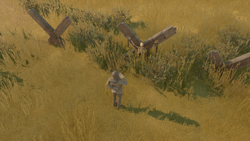
We know colonial forces would manage to continue pushing into Caoiva, even reaching as far north as Basin Sionnach,[49] but with the help of their newfound allies the Wardens would manage to hold on despite the occupation of most of their country. The Nevish Alliance itself would continue expanding, incorporating countries such as Sorovia or Edel.[48][58] Furthermore, Mesean interests in foreign lands, such as the far western continent of Katoma,[59] would further escalate the conflict and expand it to new fronts.
As a side note, it is this time that a group of pirates and smugglers known as the Hanged Men would begin to operate at large. Composed of deserters from both sides, they would become a thorn on the side of both warring factions.[58][60] At one point they would take over or possibly build the Abandoned Armouries,[61][62][63] using them to store Relic Vehicles and other old technologies.[34] In modern times these have been broken into and their contents sacked, with remains of a great battle utilising these old designs found along the Kirkyard in the Weathered Expanse.[64]
The Burnout
The aptly named Burnout[65] is characterised by a period of exhaustion among the participants of the Great Wars due to an overuse of resources and manpower, leading to the conflict reaching a generally dormant state, at least on the Caoivish-Velian front. By this time, the period of the Great Wars is considered to have ended,[66] but it is unknown when the Burnout properly began. It continues to modern day, which is believed to be sometime in the early 1000s.
This era is also credited with a "loss of technology", but that is not an accurate statement. While many blueprints and designs have been lost to time,[34] for example due to raids on production plants, the general technical knowledge has remained the same. For example, the Warden Flood Mk. I is credited to have been designed during this period. The reason we no longer see as much high quality equipment fielded is the aforementioned lack of resources, qualified manpower,[62] and logistic lines; but they would certainly be fielded again if such conditions were met.[67] Another reason for the reduced quality is the constant recycling of scrap and vehicle components,[68] no longer using the quality metals and alloys of the past.[37]
Resources are known to have already started dwindling during the Boreal Wars, both in the north and south,[52][69] and likely only got worse over time. Much later, long after the embers of the Boreal Wars had cooled, the Wardens would march south meeting little resistance until they reached a bountiful and idyllic valley. The fighting that occurred there was so devastating it is believed to have triggered a catastrophic volcanic eruption, leaving behind no survivors.[22] After this, the conflict would eventually finally settle down on a stalemate around the River Mercy.[70]
It is roughly around this point that the game would theoretically take place. However, it must be specified that the so called "Player Wars" are not canon to the world of Foxhole, with some mechanics such as the Technology Tree being simply that, game mechanics.[71] This is why the world map appears to be "frozen" in time, themed around the season of late autumn or early winter.[72]
In regards to the state of the factions around this time, shortly before the year 1000, the young Fionn Mercy would be elected as the Caoivish Archon, and could possibly be ruling to this day. His popularity is debatable, as his excessive spending during the turn of the millenium celebrations would lead to the largest riots the Nevish Alliance had seen. While the alliance is noted to have made great gains, events such as these threaten to undo all this progress.[73] As for the Mesean Republic, we know that by the year 1005 it would have grown to a total of sixteen member states,[74] having reached a considerable size. It too suffers from internal strife; with known revolts having occurred in places such as Dimiourg,[75] or even Kraunia.[76] However, nothing seems to imply any imminent collapse or large-scale crisis.
History Books
The game world contains some readable lore elements relating to the world's history:
References
- ↑ 1.0 1.1 Weathered Expanse Description
- ↑ 2.0 2.1 2.2 2.3 2.4 Chronicle of Ashes - Whedon's Row: Chapter IV
- ↑ 3.0 3.1 3.2 Howl County Description
- ↑ Viper Pit Description
- ↑ Clanshead Valley Description
- ↑ A Brief History of Caoiva Vol. III
- ↑ This is believed due to the geographical location of these states and cultural similarities with Mesea proper, but should not be taken as confirmed canon
- ↑ While there are no direct mentions of a change in government, it is assumed due to Mesea currently being a republic and not being led by an emperor
- ↑ Officer's Regalia Description
- ↑ Morgen's Crossing Description
- ↑ Callahan (Battleship) Description
- ↑ 12.0 12.1 12.2 12.3 12.4 A Brief History of Caoiva Vol. II
- ↑ 13.0 13.1 Callum's Cape Description
- ↑ History Book
- ↑ Faction selection screen text
- ↑ Endless Shore Description
- ↑ Great March Description
- ↑ 18.0 18.1 Red River Demo Lore
- ↑ This is not directly stated, but monarchist forces such as the famed Velian Royal Vanguard is nowhere to be seen and the nobility had to rely on Callahan making an entirely new army for them
- ↑ 20.0 20.1 Kalokai Description
- ↑ Developer Comments
- ↑ 22.0 22.1 Ash Fields Description
- ↑ 23.0 23.1 23.2 Red River Description
- ↑ 24.0 24.1 A Brief History of Caoiva Vol. I
- ↑ Ava Gibbs Retort
- ↑ Westgate Description
- ↑ Journal of a Grieving Highlander
- ↑ Not directly stated, but it is mentioned Caoiva has a history "assimilating" border towns as well as sending religious missionaries
- ↑ Letter to Juno
- ↑ The Taurine Rigger is described to have been in use by the Legion for three centuries, implying a close relationship
- ↑ This is assumed by logical technological progression and what kind of weaponry was used at the start of the Great Wars
- ↑ Storm Tank Description
- ↑ Armoured Fighting Tractor Description
- ↑ 34.0 34.1 34.2 A Personal Treatise on the Impact of the Hanged Men
- ↑ Morgen's Crossing Description
- ↑ 36.0 36.1 36.2 Inner Haven Vol. 1
- ↑ 37.0 37.1 Heavy Infantry Carrier Description
- ↑ Lance-25 “Hasta” Description
- ↑ Letter to a Consul
- ↑ Farranac Coast Description
- ↑ Old Tent
- ↑ 42.0 42.1 Terminus Description
- ↑ 43.0 43.1 Grave of Thea Maro
- ↑ Musings of a Deserting Soldier
- ↑ Marban Hollow Description
- ↑ The Drowned Vale
- ↑ 47.0 47.1 Old Transcript
- ↑ 48.0 48.1 Chronicle of Ashes - Whedon's Row: Chapter I
- ↑ 49.0 49.1 Basin Sionnach Description
- ↑ Callahan's Passage Description
- ↑ Reaching Trail Description
- ↑ 52.0 52.1 H-5 "Hatchet" Lore
- ↑ Sableport Description
- ↑ Hand-Delivered Letter
- ↑ Nevish Line Description
- ↑ Inner Haven Vol. 2
- ↑ The "Inner Haven" series of magazines is a literal Colonial propaganda outlet
- ↑ 58.0 58.1 Letter From the Office of the Archon
- ↑ Catena rt.IV Auto-Rifle Description
- ↑ Mouldy Letter
- ↑ Explorer's Journal
- ↑ 62.0 62.1 Engineer's Notes
- ↑ Mad Scrawlings
- ↑ These can be observed in-game
- ↑ Flood Mk. I Lore
- ↑ Some descriptions seem to imply this, need to be cited
- ↑ Rail Work Instructions
- ↑ This is observed in the resource collection mechanics of the game
- ↑ Umbral Wildwood Description
- ↑ This is the standard starting condition of a typical Foxhole World Conquest
- ↑ Generally game mechanics are inspired by the setting of the world, but are not canon to it
- ↑ Developer commentary, must be cited
- ↑ Nevish Alliance Notes
- ↑ Mesean Senate Notes
- ↑ O-75b “Ares” Description
- ↑ A Chronicle of Ashes - Flowers for Marta: Chapter I


